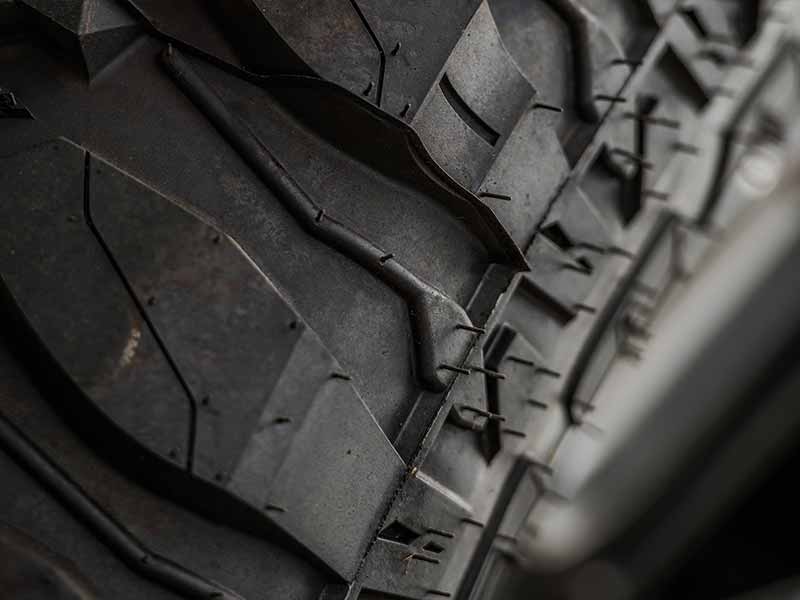Tire sizes. They look like secret codes, don’t they? Just a jumble of numbers and letters. But did you know understanding those codes can help improve your driving experience and even save you money?
245/65 R17 In Inches
The tire size “245/65 R17” translates to a tire that is approximately 9.65 inches wide with a sidewall height of about 6.27 inches, and a total tire height of 29.5 inches.
In contrast, the size “245/70 R17” represents a tire of the same width, but with a slightly taller sidewall height of about 6.75 inches, and increases the total tire height by 1 inch to 30.5 inches.
In this article, we’ll decode the meaning behind tire sizes, with a special focus on ‘245/65 R17’ and ‘245/70 R17’. We’ll delve into the significance of each number and letter, explore the impact of these measurements on vehicle performance, and even consider potential alternative sizes. By the end, you’ll be well-equipped to make informed decisions about the best tires for your vehicle.
Let’s take a closer look.
Understanding Tire Measurements
Tire measurements! You’ve probably seen them a hundred times on the side of your tires but, if you’re like most people, those numbers and letters might as well be written in another language. No worries, though. By the end of this section, you’ll be speaking fluent ‘tire-ese’. Let’s break it down!
What Do Tire Sizes Mean?
Tire sizes, like 245/65 R17, may seem confusing at first, but they’re actually pretty straightforward. This size is composed of three parts:
- 245 – The Section Width
- 65 – The Aspect Ratio
- R17 – The Rim Diameter
The Section Width is the measurement of the tire’s width from sidewall to sidewall. This number is given in millimeters. So, in our example, 245 means the tire is 245 millimeters wide.
The Aspect Ratio, the next number, is a little trickier. This number represents the height of the tire’s sidewall as a percentage of the section width. In our 245/65 R17 example, the 65 means the tire’s sidewall height is 65% of the tire’s width. Cool, right?
Last but not least, The Rim Diameter. This number, written in inches, is the diameter of the wheel that the tire is intended to fit on. So, our R17 means the tire is designed to fit a 17-inch wheel.
Important Tire Terms
To make sure we’re all on the same page, let’s go through some of the key terms we’re going to be using throughout this article.
Diameter is a straight line passing from side to side through the center of a body or figure, especially a circle or sphere. In our case, it’s the distance across the tire or wheel.
A Wheel is the circular object that sits inside of your tire, and along with the tire, makes contact with the road surface.
The Circumference is the distance around the edge of the tire – imagine if you took a marker and drew a line all the way around the outer edge of your tire, the length of that line would be the circumference.
Revolutions Per Mile are pretty much what they sound like – the number of times a tire will revolve in one mile of travel. Lower numbers indicate a larger tire, and higher numbers indicate a smaller tire.
245/65 R17 Tires: What the Numbers Mean in Inches
Welcome back, tire enthusiasts! Now that we’ve got the basics of tire measurements down, let’s take a closer look at what 245/65 R17 means in good ol’ inches.
Breaking Down 245/65 R17
Remember how we talked about section width, aspect ratio, and rim diameter? Let’s apply what we’ve learned to our 245/65 R17 example.
Section Width
The 245 in our tire size represents the section width, meaning our tire is 245 millimeters wide. But we’re dealing with inches here, so let’s convert. There are approximately 0.03937 inches in a millimeter, so 245 millimeters is roughly 9.65 inches. That’s almost as wide as a standard sheet of paper!
Sidewall Height
Next up is the aspect ratio, which in our case is 65. This tells us the height of the tire’s sidewall as a percentage of the section width. So, we take 65% of our section width (9.65 inches) and we get about 6.27 inches. That’s taller than your average smartphone!
Rim Diameter
Finally, the R17 in our tire size tells us the tire is made to fit a wheel with a diameter of 17 inches. Easy enough, right?
Overall Diameter and Tire Height
When you put these measurements together, you get the overall diameter of the tire. This is the total height of the tire—sidewall height, wheel, and all. To calculate this, we just need to add together twice the sidewall height (because tires have two sidewalls, one on top and one on the bottom) and the diameter of the wheel. So for our example:
(6.27 inches x 2) + 17 inches = about 29.54 inches
That’s the overall diameter of a 245/65 R17 tire!
Impact on Vehicle Performance
Understanding these measurements isn’t just for show, it can have a real impact on your vehicle’s performance. For example, a wider tire (larger section width) can offer better grip and stability, but might increase rolling resistance, which can affect fuel efficiency. Similarly, a taller tire (larger overall diameter) might offer better comfort and obstacle clearance, but it could also lead to more road noise. It’s all about finding the right balance for your needs!
Comparison: 245/65 R17 vs 245/70 R17
Alright, friends, it’s time to put on your comparison caps! Let’s take what we’ve learned so far and apply it to comparing two different tire sizes: 245/65 R17 and 245/70 R17. Can you spot the difference already? Let’s dive in!
The Nitty-Gritty: Similarities and Differences
First, let’s talk about what these two tire sizes have in common. The 245 and the R17 parts are identical. This means both tires have the same section width (245 millimeters or about 9.65 inches) and are designed to fit on the same rim diameter (17 inches).
The difference between these two sizes lies in the second number – the aspect ratio. The 245/65 R17 tire has an aspect ratio of 65, while the 245/70 R17 has an aspect ratio of 70. This 5% difference in aspect ratio results in a difference in sidewall height, which impacts the overall diameter of the tire.
Let’s do some quick math to figure out the sidewall height and overall diameter of the 245/70 R17 tire:
- Sidewall height: 245 mm (section width) x 0.70 (aspect ratio) = 171.5 mm. Converted to inches, that’s about 6.75 inches.
- Overall diameter: (6.75 inches x 2) + 17 inches = approximately 30.5 inches
This means the 245/70 R17 tire is about an inch taller than the 245/65 R17.
Impact on Vehicle Performance
So, what does this mean for your vehicle? Well, a tire with a larger overall diameter (like the 245/70 R17) will have fewer revolutions per mile compared to a smaller one. This might lead to a slight decrease in fuel efficiency but might also result in a smoother ride, as larger tires can better absorb bumps and road imperfections.
Additionally, taller tires might generate more road noise due to the increased tire surface in contact with the road. However, this can vary greatly depending on the tire’s tread design and rubber compound.
Which One Is Right for You?
Deciding between these two sizes largely depends on your driving needs and preferences. If fuel efficiency is your main concern, you might lean towards the 245/65 R17. But if you’re all about that smooth ride and better obstacle clearance, the 245/70 R17 might be your pick.
Exploring Alternative Sizes: 245/65 R17 and 245/70 R17
Hello again, tire detectives! Ever wonder if there’s a tire size that might be a better fit for your specific needs? That’s where alternative tire sizes come into play. Let’s unravel the mystery of alternative sizes for our 245/65 R17 and 245/70 R17 examples.
Why Consider Alternative Sizes?
Sometimes, the tire size that came with your vehicle isn’t the best for your current needs. Maybe you’re looking for better fuel efficiency, improved traction in adverse conditions, or a quieter ride. In these cases, an alternative tire size might just do the trick.
Potential Alternatives
If you’re considering a switch from 245/65 R17, you might look at sizes like 235/65 R17 or 255/60 R17. These alternative sizes have slightly different section widths, which could impact factors like traction and rolling resistance.
For those pondering a swap from 245/70 R17, alternative sizes like 235/70 R17 or 255/65 R17 could be interesting. Here, changing the section width could affect how the tire handles different road or weather conditions.
Remember, when considering an alternative size, you’ll want to make sure the new tire fits your vehicle’s wheel well and doesn’t interfere with any parts of your vehicle.
Impacts on Wheel Size and Wide Tires
When considering alternative tire sizes, it’s important to remember the impact on your wheels. A tire that’s too wide for your existing wheel could lead to instability or uneven wear. Similarly, a tire that’s too narrow might not support the weight of your vehicle properly.
“Going wide”, or choosing a tire with a larger section width, might give you more grip on the road, but could also lead to more road noise and increased rolling resistance, which could affect fuel efficiency.
In the end, the best tire size for you depends on a balance of comfort, performance, and safety.
Resources
Below are some links you may find helpful when learning about tires
Final Thoughts
We’ve cruised through the important basics of tire measurements, breaking down section width, aspect ratio, and rim diameter. You now know that the tire size 245/65 R17 indicates a tire that’s about 9.65 inches wide, with a sidewall height of roughly 6.27 inches, and an overall tire height of 29.5 inches.
But we didn’t stop there. We compared this with the 245/70 R17 size, learning that while they share the same width and rim diameter, the latter has a slightly taller sidewall and overall height and found that the small difference in section width translate to 1 inch overall tire height increase to 30.5 inches.
We then ventured off the beaten path to explore alternative tire sizes, proving that, sometimes, a slight adjustment can better suit your specific needs.
Good luck and happy motoring.





